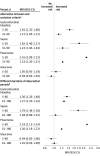Association of Oral Corticosteroid Bursts With Severe Adverse Events in Children
- PMID: 33871562
- PMCID: PMC8056312
- DOI: 10.1001/jamapediatrics.2021.0433
Association of Oral Corticosteroid Bursts With Severe Adverse Events in Children
Erratum in
-
Errors in the Abstract, Key Points, and Text.JAMA Pediatr. 2021 Jul 1;175(7):751. doi: 10.1001/jamapediatrics.2021.1760. JAMA Pediatr. 2021. PMID: 34228056 Free PMC article. No abstract available.
Abstract
Importance: The adverse effects from the long-term use of oral corticosteroids are known, but, to our knowledge, few studies have reported the risk of corticosteroid bursts, particularly among children.
Objective: To quantify the associations of corticosteroid bursts with severe adverse events, including gastrointestinal (GI) bleeding, sepsis, pneumonia, and glaucoma, in children.
Design, setting, and participants: This study used data derived from the National Health Insurance Research Database in Taiwan from January 1, 2013, to December 31, 2017, on children younger than 18 years of age and used a self-controlled case series design. Data were analyzed from January 1 to July 30, 2020.
Exposure: Oral corticosteroid bursts (defined as oral corticosteroid use for ≤14 days).
Main outcomes and measures: Incidence rates were calculated of 4 severe adverse events (GI bleeding, sepsis, pneumonia, and glaucoma) in children who did or did not receive corticosteroid bursts. Conditional fixed-effect Poisson regression was used to estimate incidence rate ratios (IRRs) of severe adverse events within 5 to 30 days and 31 to 90 days after initiation of corticosteroid bursts.
Results: Among 4 542 623 children, 23% (1 064 587; 544 268 boys [51.1%]; mean [SD] age, 9.7 [5.8] years) were prescribed a single corticosteroid burst. The most common indications were acute respiratory tract infections and allergic diseases. The incidence rate differences per 1000 person-years between children administered a single corticosteroid burst and those not prescribed corticosteroids were 0.60 (95% CI, 0.55-0.64) for GI bleeding, 0.03 (95% CI, 0.02-0.05) for sepsis, 9.35 (95% CI, 9.19-9.51) for pneumonia, and 0.01 (95% CI, 0.01-0.03) for glaucoma. The IRRs within 5 to 30 days after initiating corticosteroid bursts were 1.41 (95% CI, 1.27-1.57) for GI bleeding, 2.02 (95% CI, 1.55-2.64) for sepsis, 2.19 (95% CI, 2.13-2.25) for pneumonia, and 0.98 (95% CI, 0.85-1.13) for glaucoma; the IRRs within the subsequent 31 to 90 days were 1.10 (95% CI, 1.02-1.19) for GI bleeding, 1.08 (95% CI, 0.88-1.32) for sepsis, 1.09 (95% CI, 1.07-1.11) for pneumonia, and 0.95 (95% CI, 0.85-1.06) for glaucoma.
Conclusions and relevance: This study suggests that corticosteroid bursts, which are commonly prescribed for children with respiratory and allergic conditions, are associated with a 1.4- to 2.2-fold increased risk of GI bleeding, sepsis, and pneumonia within the first month after initiation of corticosteroid therapy that is attenuated during the subsequent 31 to 90 days.
Conflict of interest statement
Figures



Comment in
-
Kortisonstoß begünstigt bei Kindern schwere Nebenwirkungen.MMW Fortschr Med. 2021 Jun;163(11):26. doi: 10.1007/s15006-021-0067-5. MMW Fortschr Med. 2021. PMID: 34086218 Review. German. No abstract available.
-
Validation of the Association of Oral Corticosteroid Bursts With Adverse Events in Children.JAMA Pediatr. 2021 Nov 1;175(11):1186-1187. doi: 10.1001/jamapediatrics.2021.2812. JAMA Pediatr. 2021. PMID: 34424279 No abstract available.
-
Validation of the Association of Oral Corticosteroid Bursts With Adverse Events in Children-Reply.JAMA Pediatr. 2021 Nov 1;175(11):1187. doi: 10.1001/jamapediatrics.2021.2815. JAMA Pediatr. 2021. PMID: 34424284 No abstract available.
-
Maternal COVID-19 vaccine antibody response and passage into cord blood.J Pediatr. 2021 Sep;236:325-328. doi: 10.1016/j.jpeds.2021.06.055. J Pediatr. 2021. PMID: 34446174 Free PMC article. No abstract available.
References
Publication types
MeSH terms
Substances
Grants and funding
LinkOut - more resources
Full Text Sources
Other Literature Sources
Medical

